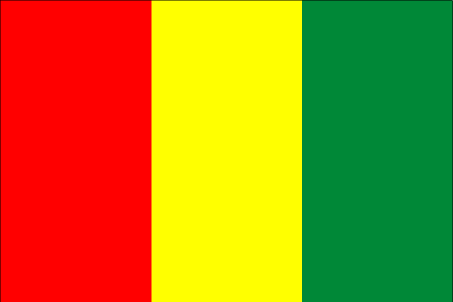Capital City - Conakry
Currency - Guinean franc
Population - 10,057,975 (as of July 2009)
National Language - French
Religion - 85% of the country is Muslim, 8% are Christian, and the remainder are made up of traditional beliefs.
Type of Government - Military Junta
Leaders - Sékouba Konaté (Acting President); Jean-Marie Doré (Prime Minister)
Country's Motto - "Travail, Justice, Solidarité" which means "Work, Justice, Solidarity."
Geographical Highlights - The Republic of Guinea is a country in western Africa. It is bordered to the north by Guinea-Bissau, Senegal, and Mali; to the east by Ivory Coast; to the south by Liberia and Sierra Leone; and, to the west by the Atlantic Ocean. Guinea is divided into four geographical regions: the Basse-Cote lowlands, the mountainous region of Fouta Djallon (which is the source of the Niger River), the northeast savanna, and the southeast Guinea Highlands. The country contains many diverse habitats including mangrove swamps, open grasslands, tropical savanna and rainforests.
History - The northeastern Guinea plains were included in what was the medieval Empire of Ghana. In the 12th century, the region was dominated by the Mali Empire; and, by the 15th century, the Songhai Empire had taken control of the land. This empire, originally founded in 700 A.D., was very powerful due to its control of most of the trade in western Africa. Its power only began to weaken as a result of factional in-fighting.
By the mid-15th century, the Portugese explorers arrived and the slave trade soon began. From the 17th century onward, many other European nations also became active in the slave trade in Guinea. In the early 18th century, the Fulani brought about a jihad and took control over the Fouta Dhallon region. After a series of wars, France won control of the entire country and, in 1891, made Guinea a French colony. France soon found fortune in mining bauxite.
In 1958, Guinea voted to become an independent nation and France severed aid and relations. Its first president, Sekou Toure, embraced Marxism and Pan-Africanism as ideologies. Opposition parties were banned and individuals with different ideas were suppressed. Following an invasion by Guinea-Bissau, the death of Toure and a military coup, the country began to improve relations with the West by introducing free-enterprise policies. The country instituted a multi-party system; however, more recently, a military junta under the command of Moussa Dadis Camara took back control of the government. Camara ordered the junta to attack any opposition by means of rape, mutilation and murder. In 2009, an aide shot Camara and he was removed as leader of Guinea. During a six-month time of transition, Sékouba Konaté has been placed in a position of power. Once the period is over, an election will be held to appoint a true president. Due to economic and political turmoil, Guinea has received the classification of a "low-income" developing nation.
Landmarks -
- Kinkon Falls - Breathtaking waterfalls outside of Pita, between the cities of Dalaba and Labé, offer a beautiful landscape.
- Kakimbon Caves - In the village of Ratoma, a suburb of the capital city of Conakry, the awe-inspiring caves are said to be of religious significance and local legend for the Baga people.
- Guinea Countryside - Quite simply, the entire country, with its variety of terrain including mountains, plains, savannahs and forests, offer a brilliant view of nature and diverse habitats.
- Guinea was the first French African colony to gain its independence.


No comments:
Post a Comment